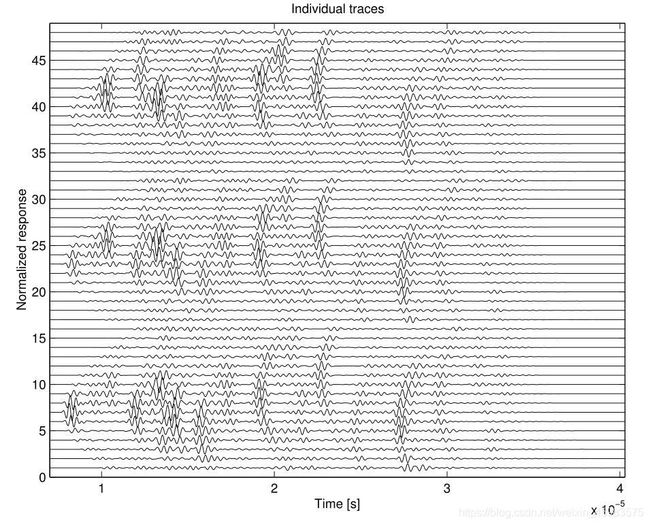field II 学习笔记1
程序说明
- calc_scat _all
- xdc_linear_array
calc_scat _all
目的: 计算从一组散射体接收到的信号的过程,以及计算孔径中每个传输和接收元件的组合的过程。这相当于一个全合成孔径扫描,每个元件发射,所有元件接收。请注意,原始数据是计算出来的。在数据上没有对焦或切趾,这必须在之后的数据上进行。一个32元件的传感器会有1024个信号。
调用:
[scat, start time] = calc_scat_all (Th1, Th2, points, amplitudes, dec factor);
参数:
| 输入 | 解释 |
|---|---|
| Th1 | 指向发射孔径的指针 |
| Th2 | 指向发射孔径的指针 |
| points | 散射点。三列向量(x,y,z),每一行代表一个散射点 |
| dec_factor | 输出采样率的抽取因子。采样频率就是 f s d e c _ f a c t o r \frac{fs}{dec\_factor} dec_factorfs |
| amplitudes | 散射振幅。行向量,元素代表每个散射点振幅 |
| 输出 | 解释 |
|---|---|
| scat | 接收电压,矩阵每个元素是一个接收单元的一个接收信号,第一个信号是单元1接收到单元1发送的信号 |
| start_time | scat中第一个样本的时间 |
示例: 计算由3个发射单元和16个接收单元组成的线性阵列的所有单元的接收响应,并绘制响应和总响应。
clear,close all, clc,
field_init;
% Set initial parameters
f0=3e6; % Transducer center frequency [Hz]
fs=100e6; % Sampling frequency [Hz]
c=1540; % Speed of sound [m/s]
lambda=c/f0; % Wavelength [m]
height=5/1000; % Height of element [m]
width=1/1000; % Width of element [m]
kerf=width/5; % Distance between transducer elements [m]
N_elements=3; % Number of elements
N_elements2=16; % Number of elements
focus=[0 0 40]/1000; % Initial electronic focus
% Define the transducers
Th = xdc_linear_array (N_elements, width, height, kerf, 2, 3, focus);
Th2 = xdc_linear_array (N_elements2, width, height, kerf, 2, 3, focus);
% Set the impulse response and excitation of the emit aperture
impulse_response=sin(2*pi*f0*(0:1/fs:2/f0));
impulse_response=impulse_response.*hanning(max(size(impulse_response)))';
xdc_impulse (Th, impulse_response);
xdc_impulse (Th2, impulse_response);
excitation=sin(2*pi*f0*(0:1/fs:2/f0));
xdc_excitation (Th, excitation);
% Define a small phantom with scatterers
N=200; % Number of scatterers
x_size = 20/1000; % Width of phantom [mm]
y_size = 10/1000; % Transverse width of phantom [mm]
z_size = 20/1000; % Height of phantom [mm]
z_start = 5/1000; % Start of phantom surface [mm];
% Create the general scatterers
x = (rand (N,1)-0.5)*x_size;
y = (rand (N,1)-0.5)*y_size;
z = rand (N,1)*z_size + z_start;
positions=[x y z];
% Generate the amplitudes with a Gaussian distribution
amp=randn(N,1);
% Do the calculation
[v,t]=calc_scat_all (Th, Th2, positions, amp, 1);
% Plot the individual responses
[N,M]=size(v);
scale=max(max(v));
v=v/scale;
for i=1:M
plot((0:N-1)/fs+t,v(:,i)+i,'b'), hold on
end
hold off
title('Individual traces')
xlabel('Time [s]')
ylabel('Normalized response')
axis([t t+N/fs 0 M+1])
xdc_linear_array
目的:
调用:
Th = xdc_linear_array (no_elements, width, height, kerf, no_sub_x, no_sub_y, focus);
参数:
| 输入 | 解释 |
|---|---|
| no_elements | 物理阵元的数量 |
| width | 阵元x方向的宽度 |
| height | 阵元y方向的宽度 |
| kerf | 阵元之间x方向的距离 |
| no_sub_x | 阵元x方向子划分数 |
| no_sub_y | 阵元y方向子划分数 |
| focus[] | 固定焦点(x,y,z) |
| 输出 | 解释 |
|---|---|
| Th | 该传感器孔径指针 |
示例略
